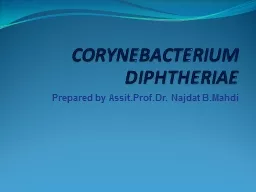

Prepared by AssitProfDr Najdat BMahdi Corynebacteria are 051 μm in diameter and several micrometers long Characteristically they possess irregular swellings at one end that give them the ID: 916288
Download Presentation The PPT/PDF document "CORYNEBACTERIUM DIPHTHERIAE" is the property of its rightful owner. Permission is granted to download and print the materials on this web site for personal, non-commercial use only, and to display it on your personal computer provided you do not modify the materials and that you retain all copyright notices contained in the materials. By downloading content from our website, you accept the terms of this agreement.
Slide1
CORYNEBACTERIUM DIPHTHERIAE
Prepared by
Assit.Prof.Dr
.
Najdat
B.Mahdi
Slide2Corynebacteria
are 0.5–1
μm
in diameter and several micrometers
long. Characteristically, they possess irregular swellings at one end that give them the
Irregularly distributed within the rod (often
near the poles) are granules staining deeply with aniline dyes(metachromatic- granules) that give the rod a beaded appearance .
Slide3Slide4Corynebacteria
are small, slender, pleomorphic, gram-positive rods
of distinctive morphology that tend to stain unevenly. They are
nonmotile
, and they do not form spores.
Corynebacterium
is a large genus of diverse habitat. Most species are
facultative anaerobes, and those associated with humans, including
the pathogen C.
diphtheriae
, grow aerobically on standard laboratory
media such as blood agar.
Slide5Corynebacterium diphtheriae
Diphtheria, caused by C.
diphtheriae
, is an acute respiratory or cutaneous
disease and may be life threatening. The development of
effective vaccination protocols and
wide spread immunization beginning
in early childhood has made the disease rare in developed
countries. However, diphtheria is a serious disease
throughout the world, particularly in those countries where the
has not been immunized
population
Slide6Epidemiology:
C.
diphtheriae
is found in the throat and
naso
-pharynx of carriers and in patients with diphtheria. This disease Is a local infection.
, usually of the throat, and the organism is
primarily spread by respiratory droplets, usually by convalescent or asymptomatic carriers. It is less frequently
spread by direct contact
with an infected individual or a contaminated fomite.
Slide7Pathogenesis
Diphtheria is caused by the local and systemic effects of a single exotoxin that inhibits eukaryotic protein synthesis.
The toxin molecule is a heat-labile polypeptide that is
composed of two fragments, A and B. Fragment B binds to susceptible
cell membranes and mediates the delivery of fragment
A to its target. Inside the cell, fragment A separates from fragment
B and catalyzes a reaction between nicotine adenine dinucleotide
(NAD+) and the eukaryotic polypeptide chain elongation
factor, EF-2 The toxin is encoded on a β-
coryne
-
phage and only those strains in which the phage is integrated
into the
C.
diphtheriae
chromosome produce toxin. Toxin gene
expression is also regulated by environmental conditions. Low
iron conditions induce toxin expression, whereas high iron
condtions
repress toxin production .
Slide8Slide9Clinical significance
Upper respiratory tract infection
: Diphtheria is a strictly localized
infection, usually of the throat. The infection produces distinctive thick, grayish, adherent exudate (
pseudomembrane
) that is composed of cell debris from the mucosa and inflammatory products. It coats the throat
and may extend into the nasal passages or downward in the
respiratory tract, where the exudate sometimes obstructs the.
airways, even leading to suffocation., generalized symptoms occur caused by production and absorption of toxin . Although all human cells are sensitive to diphtheria toxin, the major clinical effects
involve the heart and peripheral nerves. Cardiac conduction
defects and myocarditis may lead to congestive heart failure
and permanent heart damage.
Slide10Cutaneous diphtheria
A puncture wound or cut in the skin can result in introduction of C.
diphtheriae
into the subcutaneous tissue, leading to a chronic,
nonhealing
ulcer with a gray membrane. Rarely, exotoxin production leads to
tissuem
degeneration and death.
Slide11Diagnostic Laboratory Tests
Dacron swabs from the nose, throat, or other suspected
lesions must be obtained before antimicrobial drugs are
administered. Swabs should be collected from beneath any
visible membrane. The swab should then be placed in semisolid
transport media such as
Amies
. Smears stained with
alkaline methylene blue or Gram stain show beaded rods in
typical arrangement.
Specimens should be inoculated to a blood agar plate (to
rule out hemolytic streptococci) and a selective medium such
as a
tellurite
plate (
eg
,
cystine-tellurite
blood agar [CTBA] or
modified
Tinsdale’s
medium) and incubated at 37°C in 5% CO2.
Plates should be examined in 18–24 hours. In 36–48 hours, the
colonies on
tellurite
medium are sufficiently definite for recognition
of C
diphtheriae
. On
cystine
tellurite
agar, the colonies
are black with a brown halo.
Slide12A presumptive C diphtheriae isolate should be subjected
to testing for
toxigenicity
1. Modified
Elek
immunoprecipitation
method described
by the World Health Organization
.
2. Polymerase chain reaction (PCR)–based methods have
been described for detection of the diphtheria
toxin gene .
3. Enzyme-linked
immunosorbent
assays can be used
to detect diphtheria toxin
4. An
immunochromatographic
strip assay allows detection
of diphtheria toxin in a matter of hours
..
The latter two assays are not widely available.
Slide13Immunity: Diphtheria toxin is antigenic and stimulates the production of antibodies that
(
neutralize the toxin’s activity.(Note: Formalin
treatment of the toxin produces a toxoid that retains
the antigenicity but not the toxicity of the molecule.
Slide14Prevention:
The corner stone of diphtheria prevention is immunization with toxoid, usually administered in the
DTaP
triple vaccine, together with tetanus toxoid and pertussis antigens . The initial series of injections should be started in infancy. Booster injections of diphtheria toxoid (with tetanus toxoid) should be given at approximately 10-year intervals throughout life. The control of an epidemic outbreak of diphtheria involves rigorous immunization and a search for healthy carriers among patient contacts.
Slide15REFERENCES
Medical
Microbiology-
Jawetz
,
Melnick
, &
Adelberg
’
2016)
)
Twenty-Seventh Edition
Lippincott’sIllustrated
ReviewsMicrobiologThird
Edition